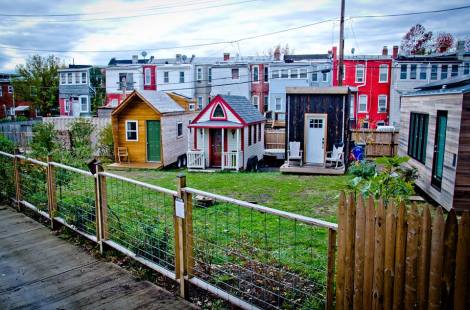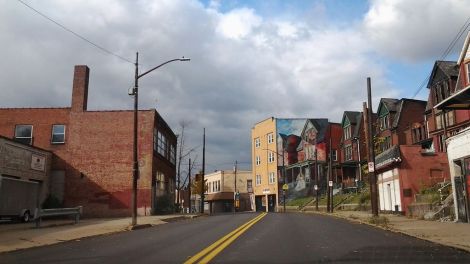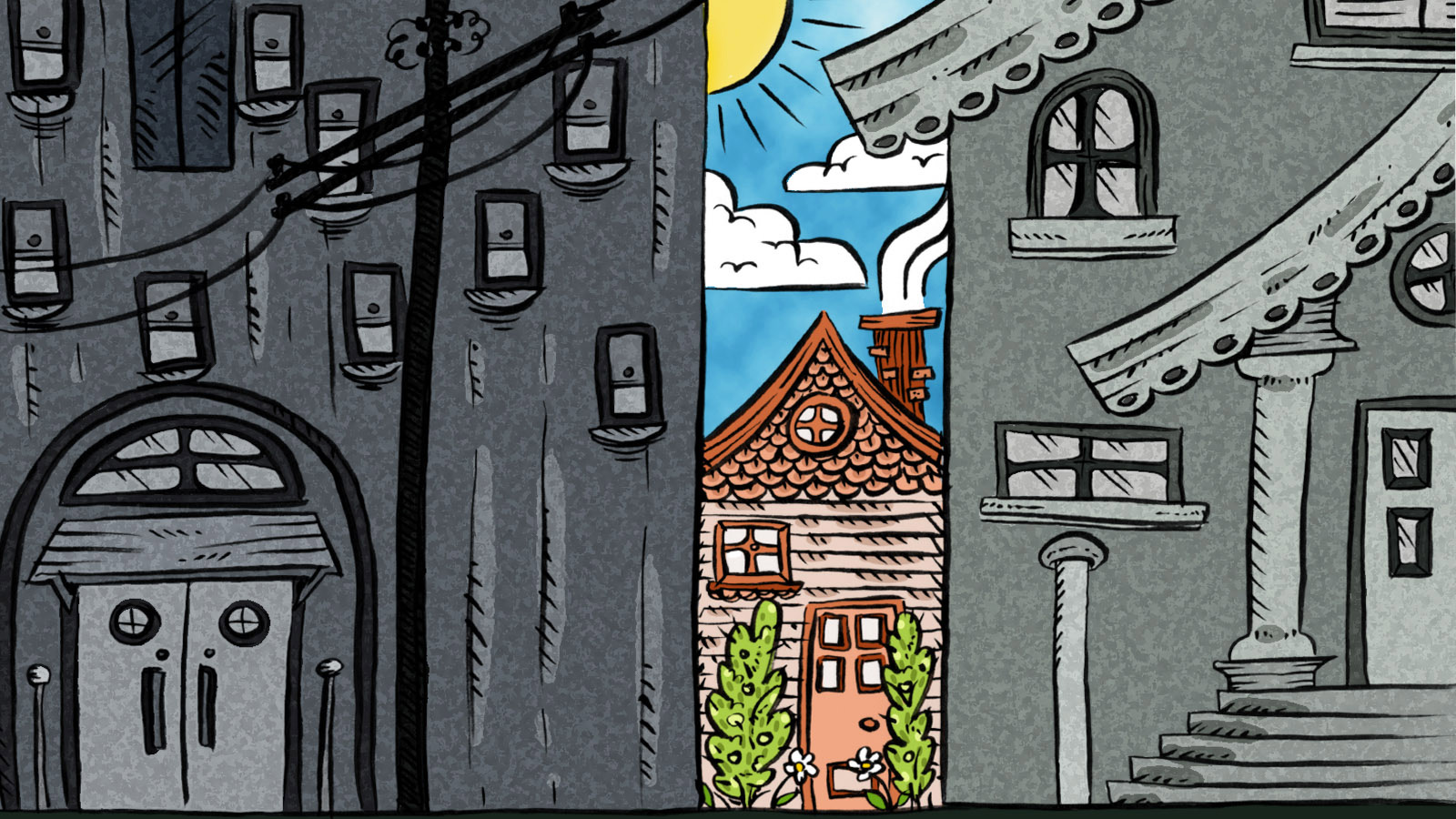If you’re looking for tiny houses in cities, prepare to look in unconventional spaces.
In Tokyo, for example, on a plot the size of a parking spot, a tiny house is tucked into the corner of a busy intersection. In Seattle, you’ll find one on a pie-slice of land smushed up against a standard-size home (evidence of a bad divorce). In Warsaw, you’ll have to peer into a three-foot-wide gap between buildings.
We’ve all heard it before: Cities are growing. Everyone wants to live in a city. Young people are sprinting into cities as quickly as their dumb pants will allow. And while there’s been some talk of city centers beginning to draw people back in from the suburbs in recent years, it’s undeniable that sprawl is still very much a component of metropolitan growth in the United States. The much-beloved youth mecca of Austin, for example, grew in population by 51 percent between 2000 and 2010, but that growth was accompanied by a 64 percent increase in land area. Let’s say it together, now: Sprawl is not sustainable! Unused space in cities is not an option we can afford.
So: How should one fill an awkward, leftover space? Some would argue that the best solution is to put a tiny house on it. But for the vast majority of the United States, tiny houses represent uncharted territory, and building one in a city poses a whole slew of questions: How should it be zoned? Where can I put it? According to the laws of the city I live in, is there such a thing as too tiny? These questions are often met with a fair bit of head-scratching, because relatively speaking, American cities are just starting to learn how to deal with tiny houses themselves.
Boneyard Studios, in Washington, D.C., is a community of three artfully designed tiny houses on wheels. It’s been set up on a small lot off of one of the capital’s narrow alleyways. Because of D.C.’s zoning laws, which prohibit building a permanent structure on a lot facing a road less than 30 feet wide, the space would otherwise be vacant.
“I think there are plenty of pieces of land, like where we are, that are unused and can’t be built on,” says Lee Pera, Boneyard Studios’ cofounder. “Tiny houses could be a good fit for spaces like this. Now folks walk down the alley all the time and they say, ‘You guys have done such an amazing job, it looks so beautiful.’ And they’re really interested in the houses because they’re all different designs. That was one of our main goals, to show that a tiny house community doesn’t need to look a certain way.”

Boneyard StudiosBoneyard Studios, in Washington, D.C., is an urban tiny house community on an alley lot.
Because all three of the houses were constructed on trailer bases, they didn’t have to comply with city building code regarding minimum dwelling size. Still, according to city law, Pera and her partners at Boneyard Studios aren’t allowed to live there full-time. The space is identified as a “tiny house community showcase,” although Pera emphasizes that she’s been working to emphasize “community” over “showcase” by organizing workshops and group events in addition to tours.
On her own time, she’s also working to create some kind of standards and best practices for building tiny houses in cities.
“Tiny houses started because people were kind of trying to get around building and zoning code,” says Pera. “A lot of tiny house people have this independent streak — like, ‘I’m building one because I don’t want to follow zoning and code.’ But now that the movement is growing … some of us are saying that in order for this to ever gain sort of mainstream acceptance, you have to be building to some sort of standards and codes. You can’t just ignore them.”
Elizabeth Roberts is a real-estate attorney for the City of Atlanta by day, tiny house enthusiast by night. Roberts tells me that one of the most likely ways tiny dwellers will avoid legal hurdles is by adding their houses to existing, larger residential properties, as backyard or side-yard cottages. The industry term is “accessory dwelling unit,” or more colloquially, ADU.
I ask Roberts if she knew of any municipalities that were working to incorporate provisions for tiny houses into their building and zoning code.
“Yes — and you’re probably going to find them in more places than you care to. However, if you ask [city planners] about tiny houses, they won’t [necessarily] know what that means,” Roberts says. “But if you ask them about ADUs, they’ll say, ‘Oh yeah, sure! We’re actually doing all kinds of things to be able to allow for those.’”
One of the cities actively working to allow for ADUs — rather unsurprisingly — is Portland, Ore. I spoke with Eric Engstrom, who works for Portland’s Department of Planning and Sustainability. I ask him what he thought the biggest factor that pushed the city to consider tiny houses had been.
“Affordability,” he says, without missing a beat. “I think Portland is not unique in this situation, but we’re going to be pricing our own population out of the city if we’re not careful with the way that property values are rising. It’s a really popular place for people to move to and the housing supply is limited, so it’s causing gentrification and driving people out of neighborhoods. There’s sort of the fear of becoming San Francisco, if you will, in terms of the housing market.”
So how do tiny houses contribute to more affordable housing? Says Engstrom: “Since land is limited, one easy way to provide more housing options is just to start allowing more creative, infill types of housing.”
Engstrom tells me that there’s still work to be done — having multiple miniature dwellings on one lot, for example, isn’t allowed. The legality of such a setup comes down to exciting issues such as revising the city’s laws of what constitutes a kitchen. All digs at the unsexy ins and outs of urban planning aside, though, small code changes can make a big difference for tiny houses.
In that regard, Roberts tells me that anyone trying to make tiny houses happen in their city should make their case to the local government.
“It’s crucial that you have discussions with the local zoning and planning boards,” she says. “There’s a communication piece to go along with those discussions: We [tiny house people] actually add good neighbors, we add density, we provide for expanded use. All of that needs to be brought to the forefront — basically, educating the community.”
Back in Boneyard Studios’ hometown, the Coalition for Smarter Growth has been advocating for an update to D.C.’s zoning code to allow for ADUs.
In Pittsburgh, cityLAB’s 6% Place project is exploring standalone tiny houses as an option for affordable housing in the inner-city neighborhood of Garfield. I spoke with Eve Picker, CEO and president of cityLAB, about what that project is going to look like. Basically, cityLAB is creating a manual for anyone who might want to build a tiny house in Pittsburgh by constructing one on a vacant lot in Garfield and documenting the process online.

real00Garfield, the Pittsburgh neighborhood where cityLAB plans to construct a tiny house.
In December, cityLAB held a community meeting to gauge public interest in tiny houses — which was packed, Picker tells me. She had originally envisioned the project to have a significant design component, including hiring multiple architects to draw up proposals for the tiny house model. But when she spoke with people who were seriously considering building miniature homes, she found that figuring out how the house would look wasn’t their biggest question.
“What we found was that design was important, but most people thinking about building a tiny house already have a really clear [design] idea in mind,” says Picker. “What they don’t know is how to buy the land, how to deal with banks, how to get an appraisal, how to hire an architect, how to deal with zoning issues — thousands of questions like that really stop them in their tracks.”
There are plenty of online resources for designing — and even constructing — your own tiny house, but Picker found that they were severely lacking when it comes to actually building and owning one in a city.
“Most of them just say: ‘Here are all the options you can build, here’s how wonderful they are, and here’s the process of building them.’ But they don’t really deal with the nitty-gritty of the background work of getting a house built and owning it,” Picker says.
The lot that cityLAB chose to build on is very small — and that’s exactly why they picked it.
“I must say the reason why I like this site that we’ve chosen, is that it’s a really tiny site,” says Picker. “It’s not what the neighborhood group initially wanted us to do — they wanted us to tackle something larger. But this tiny site is perfect. It’s close to the main street, so someone could live there without a car. It’s sandwiched between buildings, so no one’s going to build on it. So for me, it offers the perfect challenges for an urban tiny house, and shows the possibilities for some leftover piece of land.”
I was delighted to hear Picker say this, because after a bit more than two months of tiny house research, this is exactly how I’ve come to see tiny houses: green, clean options to fill weird little spaces. The houses themselves, however, are maybe not so strange after all — nor are their inhabitants.
In spite of tired comparisons to clown cars, people who live in tiny houses are not circus freaks. If you were to open the door to an American tiny house, inside you might find a young couple that just wants to try building something with their own hands, a middle-aged woman looking to downsize after her kids are grown, or a recovering addict who is finally getting an opportunity to change his life for the better. These are all normal people, for whom a very small house simply makes sense.
And why is that? They’re a balancing response to the oversize, overpriced, resource-guzzling megahomes that have overwhelmed the American housing market for decades. They’re a cheap housing option for people who would otherwise go without shelter. And now, from Portland to Pittsburgh, more cities across the United States are starting to see them as a way to create more housing in overstretched markets.
Does all this mean that you have to forsake all your possessions and move into a tiny house immediately? No, it does not — no one is suggesting that the tiny house way of life is for everyone. But it does suggest that you should at least pause before ridiculing someone who has made that choice, because he or she might just be making your city a bit more sustainable.



